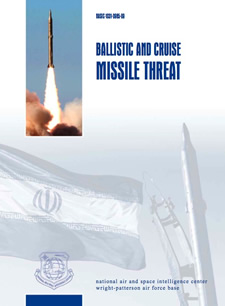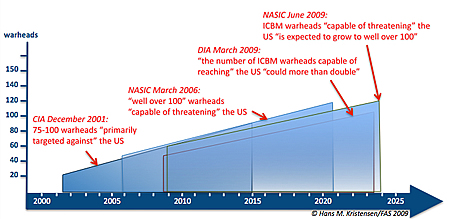Nuclear Modernization Briefings at the NPT Conference in New York

By Hans M. Kristensen
Last week I was in New York to brief two panels at the Third Session of the Preparatory Committee for the 2015 Review Conference of the Parties to the Treaty on the Non-Proliferation of Nuclear Weapons (phew).
The first panel was on “Current Status of Rebuilding and Modernizing the United States Warheads and Nuclear Weapons Complex,” an NGO side event organized on May 1st by the Alliance for Nuclear Accountability and the Women’s International League for Peace and Freedom (WILPF). While describing the U.S. programs, I got permission from the organizers to cover the modernization programs of all the nuclear-armed states. Quite a mouthful but it puts the U.S. efforts better in context and shows that nuclear weapon modernization is global challenge for the NPT.
The second panel was on “The Future of the B61: Perspectives From the United States and Europe.” This GNO side event was organized by the Nuclear Age Peace Foundation on May 2nd. In my briefing I focused on providing factual information about the status and details of the B61 life-extension program, which more than a simple life-extension will produce the first guided, standoff nuclear bomb in the U.S. inventory, and significantly enhance NATO’s nuclear posture in Europe.
The two NGO side events were two of dozens organized by NGOs, in addition to the more official side events organized by governments and international organizations.
The 2014 PREPCOM is also the event where the United States last week disclosed that the U.S. nuclear weapons stockpile has only shrunk by 309 warheads since 2009, far less than what many people had anticipated given Barack Obama’s speeches about “dramatic” and “bold” reductions and promises to “put an end to Cold War thinking.”
Yet in disclosing the size and history of its nuclear weapons stockpile and how many nuclear warheads have been dismantled each year, the United States has done something that no other nuclear-armed state has ever done, but all of them should do. Without such transparency, modernizations create mistrust, rumors, exaggerations, and worst-case planning that fuel larger-than-necessary defense spending and undermine everyone’s security.
For the 185 non-nuclear weapon states that have signed on to the NPT and renounced nuclear weapons in return of the promise made by the five nuclear-weapons states party to the treaty (China, France, Russia, United Kingdom, and the United States) “to pursue negotiations in good faith on effective measures relating to the cessation of the nuclear arms race at early date and to nuclear disarmament,” endless modernization of the nuclear forces by those same five nuclear weapons-states obviously calls into question their intension to fulfill the promise they made 45 years ago. Some of the nuclear modernizations underway are officially described as intended to operate into the 2080s – further into the future than the NPT and the nuclear era have lasted so far.
Download two briefings listed above: briefing 1 | briefing 2
This publication was made possible by a grant from the Ploughshares Fund. The statements made and views expressed are solely the responsibility of the author.
Using Trade to Build Stability in South Asia
Former Pakistani Prime Minister Zulfiqar Ali Bhutto once said, “If India builds the bomb, Pakistan will eat grass, even go hungry, but we will get our own.”1 Today, Pakistan has had the bomb for more than 13 years2, yet according to expert estimates the Pakistanis are building nuclear weapons faster than anyone else in the world.3 Meanwhile, Pakistan’s economy continues to deteriorate at such a rate that its people resorting to grass as sustenance may actually become a reality. Economists forecast that Pakistan’s GDP must expand at a minimum of 3 percent just to maintain current living standards and keep up with the rapidly expanding population.4
With the rapid spread of Islamic extremism and tensions growing daily between the civilian government, the courts, and the military, the prospect of an increasing number of nuclear weapons in Pakistan sparks fear that one of these weapons could fall into the wrong hands. Given the risks involved with a destabilized Pakistan, there is an obvious and pressing need to improve the security situation in South Asia, a region home to nearly one-fifth of the world’s population.
The tensions between India and Pakistan date back to their partition in 1947 into separate countries. Since then, the two have fought a total of four wars, mostly over the disputed territory of Kashmir. Pakistan has been suspected of supporting a militant insurgency in Indian administered Kashmir since the mid-1980s, while India is alleged to support an insurgency in Pakistan’s Balochistan Province.5 This strained relationship prompted the development of both countries’ nuclear weapons programs, while security concerns on Pakistan’s western and eastern borders – partly a legacy of Pakistani and U.S. support for militants along its western frontier during the Soviet invasion of Afghanistan in 19796 – have led to disproportionate military influence in Pakistan’s politics and administration. As a result, the country has experienced three periods of military dictatorship, which have severely limited the country’s ability to build and maintain viable democratic institutions.7
Given the bleak situation between India and Pakistan is it even possible to build better relations? Improving bilateral trade is one way to potentially foster collaboration between the two states, but the last 65 years have demonstrated how difficult it is for India and Pakistan to make progress on security related issues. Kashmir remains in dispute: thousands of Indian and Pakistani soldiers remain perched high on the Siachen Glacier, a desolate piece of ice where more soldiers die from avalanches than enemy fire. Nevertheless, there remains a real threat that conflict can erupt anytime at Siachen, the world’s highest battlefield. Simultaneously, a significant portion of Indian and Pakistani society remains marred in poverty. The collaboration required to build better trade relations has the potential to positively impact the situation of both countries and perhaps bring India and Pakistan closer together.
South Asia Today
India and Pakistan face precarious times: millions remain in poverty on both sides of the border, as both countries face deteriorating rates of economic growth. Pakistan is forecasted to miss its target of 4.2 percent GDP growth rate this year, while India has had to cut its GDP growth forecast to 5 percent.89 At the same time, a continuing population boom means that this modest economic growth will most likely not be enough to improve upon or even maintain the quality of life for Indians and Pakistanis. With the anticipated U.S. withdrawal from Afghanistan in December 2014 there is additional potential for instability in the region, as a reduction in Western engagement could spark greater unrest in the tribal belt separating Pakistan and Afghanistan. Instability and violence from this region could spread to the rest of Afghanistan and Pakistan, ultimately negatively impacting India as well.
Improving trade relations and engaging in greater trade could be a way for India and Pakistan to improve their economies. Although the situation they face is not promising, the domestic political situation in both countries suggests that now is the best time to make improvements in trade relations a reality. With the May 11,2013 Pakistani elections, Nawaz Sharif’s Pakistan Muslim League Nawaz (PML-N) has returned to power with a solid parliamentary majority.10 Sharif has already indicated his support for improved bilateral trade relations, reaching out to his Indian counterpart Prime Minister Manmohan Singh, and inviting him to visit Pakistan.11 Similarly, Singh has also expressed his intention to build better relations with Pakistan, specifically focusing on greater trade.12 While these are promising signs for bilateral relations, it remains to be seen whether these two leaders will follow these initial overtures with real progress. Although Sharif launched a series of ambitious economic reforms during his first term, his previous two terms in office were characterized by corruption.13Singh’s government has also seen several major corruption scandals, as well as an inability to implement key economic reforms such as further liberalization of the Indian economy to encourage foreign investment.14
However, both leaders are under pressure to improve their domestic economic situation. Pakistanis elected Sharif with a wide margin of support, but will quickly become impatient if he does not deliver on his promise to improve the economic situation. Across the border in India, Singh and his Indian National Congress (INC) face parliamentary election in 2014 – signs of economic progress and reform are vital if they are to be reelected. Meanwhile, the INC’s main opposition, the Bharatya Janta Party (BJP), recently experienced a setback by losing a critical state election in Karanataka.15 Despite this, Singh and his government are still under immense pressure to improve India’s economy. Because of these domestic political situations, inaction on improving the economy is a risk that neither Nawaz Sharif nor Manmohan Singh can afford to take. Greater bilateral trade is one policy that both Sharif and Singh can adopt to improve the economies of their countries.
To boost trade from current levels, India and Pakistan must take several key steps.
1) Develop a uniform, jointly developed trade policy
Different policies govern trade at the Punjab crossing, the two Kashmiri crossings, and by sea – a common trade policy governing what goods can be traded and how trade is conducted across the various routes between India and Pakistan does not yet exist. The two countries need to establish a clear joint trade policy that outlines how present trade policies between India and Pakistan will evolve in the coming years, so that ultimately the same trade policies and practices are in place regardless of the border crossing used.
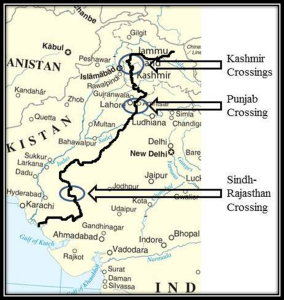
2) Pakistan must grant MFN status to India
Setting a clearer and more cohesive bilateral trade policy depends on Pakistan extending “Most Favored Nation” status to India. MFN status is important in international trade because it means that one country will not discriminate against another country in terms of trade. India has granted Pakistan MFN status since 1996. Pakistan granted India MFN status briefly in 2011, but then retracted India’s MFN status due to opposition from several key domestic industries such as agriculture and automotive sectors. Granting India MFN status would mean that Pakistan must extend the same trade preferences to India as Pakistan currently does to other countries that it has granted MFN status.
To avoid retracting this MFN status as it did in 2011, Pakistan and India must adopt a gradual process with a concrete timeline, with the ultimate goal to extend MFN status to India. The gradual process of extending MFN status could be incorporated into the overall objective of developing a clear, unified Indo-Pakistan trade policy. With a clear timeline, domestic industries in Pakistan that could be adversely affected by liberalization of trade with India have a chance to prepare and adjust to these economic shifts. To take this preparation a step further, the two countries should establish cross-border collaboration in sectors that would be the hardest hit from further Indo-Pakistan trade liberalization. Through these joint collaborations, businessmen from both countries could work together to manage the impact of extending MFN status to India. Altogether, these steps would minimize the pain felt by those who would lose out from Indo-Pakistan trade liberalization.
3) Improve infrastructure linking India and Pakistan
Pakistan and India need to improve the infrastructure connecting the two countries. From extensive delays at the seaports to poor cross border road infrastructure in Kashmir, inadequate trade infrastructure is common to all routes connecting India and Pakistan.16 To relieve strain on existing connections the two countries could open up more border crossings. Ideally, these crossings would be built with Integrative Check Posts (ICP), similar to the existing one at Wagah in Punjab. The ICP is a 120 acre facility that significantly expanded the customs and inspection facilities on the India side of the Wagah-Attari border crossings,17 allowing trade traffic between India and Pakistan to increase from 100-150 trucks per day to about 250 trucks per day.1819

Indo-Pakistan Trade across the Line of Control in Kashmir20
At the same time, it is important to acknowledge that infrastructure improvements need to take place on both sides of the border to make them effective. Although the ICP at Wagah has increased processing capacity, no comparable improvement infrastructure has taken place on the Pakistani side of the Wagah crossing, and the true benefits of improved infrastructure will only be realized when improvements are implemented on both sides of the border. In addition to physical infrastructure, the two countries also need to build up banking and legal institutions. The virtual absence of these two components has made trade in Kashmir risky and difficult to accomplish. Building these vital linkages will ensure that future growth in Indo-Pakistan trade is sustainable.
4) Improve ties between the Indian and Pakistani business communities
India and Pakistan need to improve coordination between business communities on both sides of the border. The joint Chamber of Commerce in Kashmir was successful at linking the two business communities together, even though it has not been as successful as intended for its initial purpose of liberalizing cross-Line of Control trade.21 The governments of India and Pakistan need to expand these types of business oriented organizations in places like Punjab, Sindh and Gujarat.

Dried Date Merchant, Karachi, Pakistan22
Dubai, the UAE and other third party countries currently function as meeting grounds for the Indian and Pakistani business community. This is due to the fact that it is easier to travel to these third party countries than to go across the shared border. Additionally, Indo-Pakistan trade often flows through these indirect routes to circumvent the restrictive and often convoluted trade regulations across the Indo-Pakistani border. While India and Pakistan work to build better direct trade relations, they could engage members of the Pakistani and Indian business communities by establishing organizations to facilitate interaction between them. Eventually, as relations improve, these organizations could help expedite the shift of Indo-Pakistan trade back from these third party locations.
Conclusion
Imposing greater Indo-Pakistan trade solely through policy will not be sustainable in the long run. Rather, India and Pakistan must use policy to craft an environment where trade can freely occur. However, this trade will only be sustainable if there is greater cultural awareness between the people of the two countries. A prominent businessman from Kutch in Gujarat once asked me, “Why should we trade with those terrorists?” Only when Indians and Pakistanis break away from such false perceptions can trade truly evolve into a long-term road to lasting peace.
Ravi Patel is a student at Stanford University where he recently completed a B.S. in Biology and is currently pursuing an M.S. in Biology. He completed an undergraduate honors thesis on developing greater Indo-Pakistan trade under Sec. William Perry at the Center for International Security and Cooperation (CISAC). Patel is the founder and president of a student to student collaborative research program connecting leading Pakistani and American university students and also the president of a similar organization called the Stanford U.S.-Russia Forum which connects university students in Russia and the United States. In the summer of 2012, Patel was a security scholar at the Federation of American Scientists. He also has extensive biomedical research experience focused on growing bone using mesenchymal stem cells through previous work at UCSF’s surgical research laboratory and Lawrence Berkeley National Laboratory.
Air Force Intelligence Report Provides Snapshot of Nuclear Missiles
By Hans M. Kristensen
The U.S. Air Force National Air and Space Intelligence Center (NASIC) has published its long-awaited update to the Ballistic and Cruise Missile Threat report, one of the few remaining public (yet sanitized) U.S. intelligence assessment of the world nuclear (and other) forces.
Previous years’ reports have been reviewed and made available by FAS (here, here, and here), and the new update contains several important developments – and some surprises.
Most important to the immediate debate about further U.S.-Russian reductions of nuclear forces, the new report provides an almost direct rebuttal of recent allegations that Russia is violating the INF Treaty by developing an Intermediate-range ballistic missile: “Neither Russia nor the United States produce or retain any MRBM or IRBM systems because they are banned by the Intermediate-Range Nuclear Force Treaty, which entered into force in 1988.”
Another new development is a significant number of new conventional short-range ballistic missiles being deployed or developed by China.
Finally, several of the nuclear weapons systems listed in a recent U.S. Air Force Global Strike Command briefing are not included in the NASIC report at all. This casts doubt on the credibility of the AFGSC briefing and creates confusion about what the U.S. Intelligence Community has actually concluded.
Russia
The report estimates that Russia retains about 1,200 nuclear warheads deployed on ICBMs, slightly higher than our estimate of 1,050. That is probably a little high because it would imply that the SSBN force only carries about 220 warheads instead of the 440, or so, warheads we estimate are on the submarines.
“Most” of the ICBMs “are maintained on alert, capable of being launched within minutes of receiving a launch order,” the report states. This excessive alert posture is similar to that of the United States, which has essentially all of its ICBMs on alert.
The report also confirms that although Russia is developing and deploying new missiles, “the size of the Russia missile force is shrinking due to arms control limitations and resource constraints.”
Unfortunately, the report does not clear up the mystery of how many warheads the SS-27 Mod 2 (RS-24, Yars) missile carries. Initially we estimated thee because the throw-weight is similar to the U.S. Minuteman III ICBM. Then we considered six, but have recently settled on four, as the Strategic Rocket Forces commander has stated.
The report states that “Russia tested a new type of ICBM in 2012,” but it undercuts rumors that it not an ICBM by listing its range as 5,500+ kilometers. Moreover, in an almost direct rebuttal of recent allegations that Russia is violating the INF Treaty by developing an Intermediate-range ballistic missile, the report concludes: “Neither Russia nor the United States produce or retain any MRBM or IRBM systems because they are banned by the Intermediate-Range Nuclear Force Treaty, which entered into force in 1988.”
The report also describes how Russian designers are working to modify missiles to overcome U.S. ballistic missile defense systems. The SS-27 Mod 1 (Topol-M) deployed in silos at Tatishchevo was designed with countermeasures to ballistic missile systems, and Russian officials claim that a new class of hypersonic vehicle is being developed to overcome ballistic missile defense systems, according to NASIC.
The report also refers to Russian press report that a rail-mobile ICBM is being considered, and that a new “heavy” ICBM is under development.
One of the surprises in the report is that SS-N-32/Bulava-30 missile on the first Borei-class SSBN is not yet considered fully operational – at least not by NASIC. The report lists the missile as in development and “not yet deployed.”
Another interesting status is that while the AS-4 and AS-15 nuclear-capable air-launched cruise missiles are listed as operational, the new Kh-102 nuclear cruise missile that Russian officials have said they’re introducing is not listed at all. The Kh-102 was also listed as already “fielded” by a recent U.S. Air Force Global Strike Command briefing.
Finally, while the report lists the SS-N-21 sea-launched cruise missile as operational, it does not mention the new Kalibr cruise missile for the Yasen-class attack submarine that U.S. Air Force Global Strike Command recently listed a having been “fielded” within the past five years.
China
The NASIC report states that the Chinese ballistic missile force is expanding both in size and types of missiles.
Deployment of the DF-31A (CSS-10 Mod 2) ICBM continues at a slow pace with “more than 15” launchers deployed six years after the system was first introduced.
Despite many rumors about a new DF-41 ICBM, the NASIC report does not mention this system at all.
Deployment of the shorter-range DF-31 (CSS-10 Mod 1) ICBM, on the contrary, appears to have stalled or paused, with only 5-10 launchers deployed seven years after it was initially introduced (see my recent analysis of this trend here). Moreover, the range of the DF-31 is lowered a bit, from 7,200+ km in the 2009 report to 7,000+ in the new version.
Medium-range nuclear missiles include the DF-21 (CSS-5) (in two versions: Mod 1 and Mod 2, but with identical range etc.) and the old DF-3A (CSS-2), which is still listed as deployed. Only 5-10 launchers are left, probably in a single brigade that will probably convert to DF-21 in the near future.
An important new development concerns conventional missiles, where the NASIC report states that several new systems have been introduced or are in development. This includes a “number of new mobile, conventionally armed MRBMs,” apparently in addition to the DF-21C and DF-21D already known. As for the DF-21D anti-ship missile, report states that “China has likely started to deploy” the missile but that it is “unknown” how many are deployed.
More dramatic is the development on five new short-range ballistic missiles, including the CSS-9, CSS-11, CSS-14, CSS-X-15, and CSS-X-16. The CSS-9 and CSS-14 come in different versions with different ranges. The CSS-11 Mod 1 is a modification of the existing DF-11, but with a range of over 800 kilometers (500 miles). None of these systems are listed as nuclear-capable.
Concerning sea-based nuclear forces, the NASIC report echoes the DOD report by saying that the JL-2 SLBM for the new Jin-class SSBN is not yet operational. The JL-2 is designated as CSS-NX-14, which I thought it was a typo in the 2009 report, as opposed to the CSS-NX-3 for the JL-1 (which is also not operational).
NASIC concludes that JL-2 “will, for the first time, allow Chinese SSBNs to target portions of the United States from operating areas located near the Chinese coast.” That is true for Guam and Alaska, but not for Hawaii and the continental United States. Moreover, like the DF-31, the JL-2 range estimate is lowered from 7,200+ km in the 2009 report to 7,000+ km in the new version. Earlier intelligence estimates had the range as high as 8,000+ km.
One of the surprises (perhaps) in the new report is that it does not list the CJ-20 air-launched cruise missile, which was listed in the U.S. Air Force Global Strike Command briefing as a nuclear cruise missile that had been “fielded” within the past five years.
Concerning the overall size of the Chinese nuclear arsenal, there have been many rumors that it includes hundreds or even thousands of additional warheads more than the 250 we estimate. STRATCOM commander has also rejected these rumors. To that end, the NASIC report lists all Chinese nuclear missiles with one warhead each, despite widespread rumors in the news media and among some analysts that multiple warheads are deployed on some missiles.
Yet the report does echo a projection made by the annual DOD report, that “China may also be developing a new road-mobile ICBM capable of carrying a MIRV payload.” But NASIC does not confirm widespread news media rumors that this system is the DF-41 – in fact, the report doesn’t even mention the DF-41 as in development.
As for the future, the NASIC report repeats the often-heard prediction that “the number of warheads on Chinese ICBMs capable of threatening the United States is expected to grow to well over 100 in the next 15 years.” This projection has continued to slip and NASIC slips it a bit further into the future to 2028.
Pakistan
Most of the information about the Pakistani system pretty much fits what we have been reporting. The only real surprise is that the Shaheen-II MRBM does still not appear to be fully deployed, even though the system has been flight tested six times since 2010. The report states that “this missile system probably will soon be deployed.”
India
The information on India also fits pretty well with what we have been reporting. For example, the report refers to the Indian government saying the Agni II IRBM has finally been deployed. But NASIC only lists “fewer than 10” Agni II launchers deployed, the first time I have seen a specific reference to how many of this system are deployed. The Agni III IRBM is said to be ready for deployment, but not yet deployed.
North Korea
The NASIC report lists the Hwasong-13 (KN-08), North Korea’s new mobile ICBM, but confirms that the missile has not yet been flight tested. It also lists an IRBM, but without naming it the Musudan.
The mysterious KN-09 coastal-defense cruise missile that U.S. Air Force Global Strike Command recently listed as a new nuclear system expected within the next five years is not mentioned in the NASIC report.
Full NASIC report: Ballistic and Cruise Missile Threat 2013
See also previous NASIC reports: 2009 | 2006 | 1998
This publication was made possible by grants from the New-Land Foundation and Ploughshares Fund. The statements made and views expressed are solely the responsibility of the author.
Air Force Briefing Shows Nuclear Modernizations But Ignores US and UK Programs
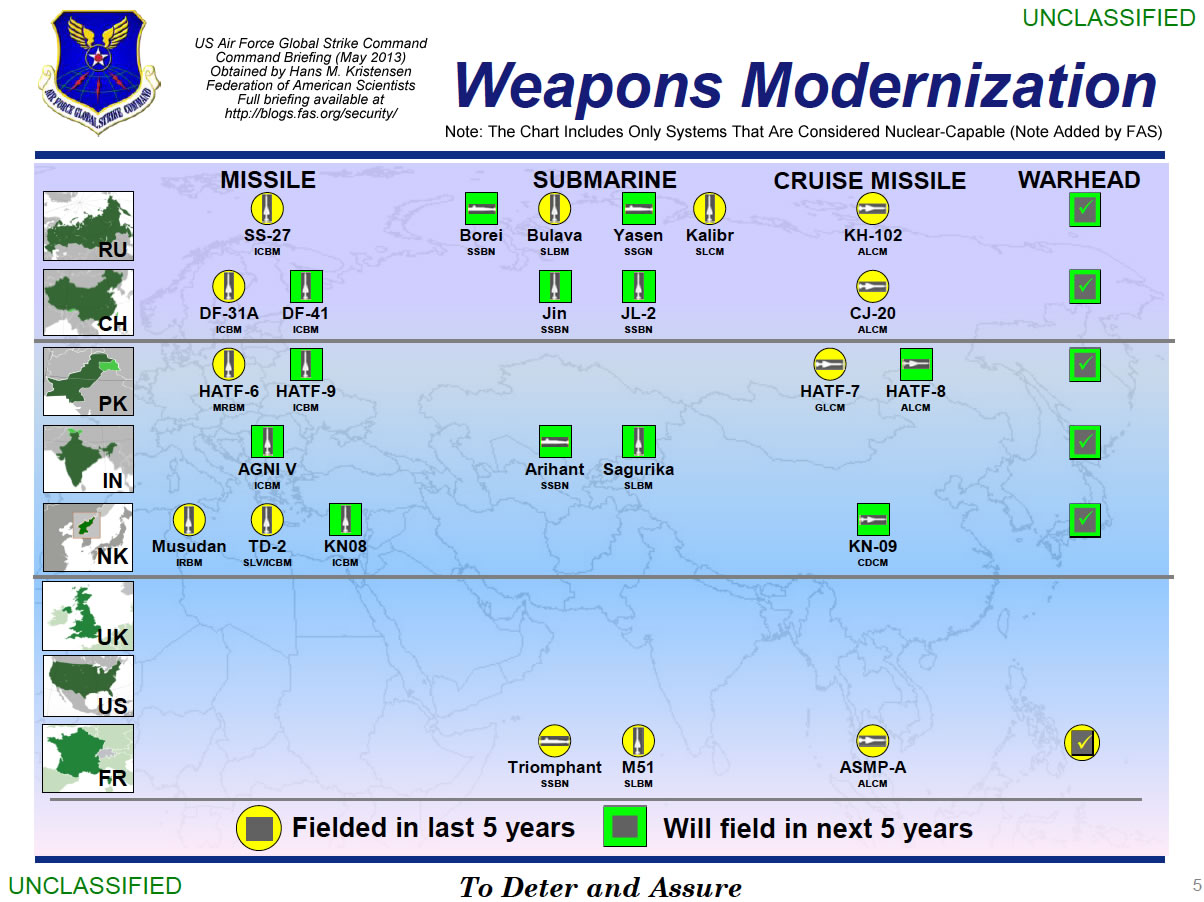
Click to view large version. Full briefing is here.
By Hans M. Kristensen
China and North Korea are developing nuclear-capable cruise missiles, according to U.S. Air Force Global Strike Command (AFGSC).
The new Chinese and North Korean systems appear on a slide in a Command Briefing that shows nuclear modernizations in eight of the world’s nine nuclear weapons states (Israel is not shown).
The Chinese missile is the CJ-20 air-launched cruise missile for delivery by the H-6 bomber. The North Korean missile is the KN-09 coastal-defense cruise missile. These weapons would, if for real, be important additions to the nuclear arsenals in Asia.
At the same time, a closer look at the characterization used for nuclear modernizations in the various countries shows generalizations, inconsistencies and mistakes that raise questions about the quality of the intelligence used for the briefing.
Moreover, the omission from the slide of any U.S. and British modernizations is highly misleading and glosses over past, current, and planned modernizations in those countries.
For some, the briefing is a sales pitch to get Congress to fund new U.S. nuclear weapons.
Overall, however, the rampant nuclear modernizations shown on the slide underscore the urgent need for the international community to increase its pressure on the nuclear weapon states to curtail their nuclear programs. And it calls upon the Obama administration to reenergize its efforts to reduce the numbers and role of nuclear weapons.
Russia
![]()
The briefing lists seven Russian nuclear modernizations, all of which are well known and have been underway for many years. Fielded systems include SS-27 ICBM, Bulava SLBM, Kalibr SLCM, and KH-102 ALCM.
It is puzzling, however, that the briefing lists Bulava SLBM and Kalibr SLCM as fielded when their platforms (Borei SSBN and Yasen SSGN, respectively) are not. The first Borei SSBN officially entered service in January 2013.
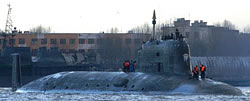
Nuclear Cruise Missile For Yasen SSGN
It is the first time I’ve seen a U.S. government publication stating that the non-strategic Kalibr land-attack SLCM is nuclear (in public the Kalibr is sometimes called Caliber). The first Yasen SSGN, the Severodvinsk, test launched the Kalibr in November 2012. The weapon will also be deployed on the Akula-class SSGN. The Kalibr SLCM, which is dual-capable, will probably replace the aging SS-N-21, which is not. There are no other Russian non-strategic nuclear systems listed in the AFGSC briefing.
A new warhead is expected within the next five years, but since no new missile is listed the warhead must be for one of the existing weapons.
China
![]()
The briefing lists six Chinese nuclear modernizations: DF-31A ICBM, DF-41 ICBM, Jin SSBN, JL-2 SLBM, CJ-20 ALCM, and a new warhead.
The biggest surprise is the CJ-20 ALCM, which is the first time I have ever seen an official U.S. publication crediting a Chinese air-launched cruise missile with nuclear capability. The latest annual DOD report on Chinese military modernization does not do so.
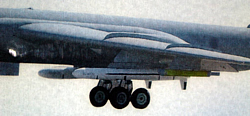
H-6 with CJ-20. Credit: Chinese Internet.
The CJ-20 is thought to be an air-launched version of the 1,500+ kilometer ground-launched CJ-10 (DH-10), which the Air Force in 2009 reported as “conventional or nuclear” (the AFGSC briefing does not list the CJ-10). The CJ-20 apparently is being developed for delivery by a modified version of the H-6 medium-range bomber (H-6K and/or H-6M) with increased range. DOD asserts that the H-6 using the CJ-20 ALCM in a land-attack mission would be able to target facilities all over Asia and Russia (east of the Urals) as well as Guam – that is, if it can slip through air defenses.
The elusive DF-41 ICBM is mentioned by name as expected within the next five years. References to a missile known as DF-41 has been seen on and off for the past two decades, but disappeared when the DF-31A appeared instead. The latest DOD report does not mention the DF-41 but states that, “China may also be developing a new road-mobile ICBM, possibly capable of carrying a multiple independently targetable reentry vehicle (MIRV).” (Emphasis added).
AFGSC also predicts that China will field a new nuclear warhead within the next five years. MIRV would probably require a new and smaller warhead but it could potentially also refer to the payload for the JL-2.
Pakistan
![]()
Pakistan is listed with five nuclear modernizations, all of which are well known: Hatf-8 (Shaheen II) MRBM, Hatf-9 (NASR) SRBM, Hatf-7 (Babur) GLCM, Hatf-8 (Ra’ad) ALCM, and a new warhead. Two of them (Hatf-8 and Hatf-7) are listed as fielded.
The briefing mistakenly identifies the Hatf-9 as an ICBM instead of what it actually is: a short-range (60 km) ballistic missile.
The new warhead might be for the Hatf-9.
India
![]()
India is listed with four nuclear modernizations, all of which are well known: Agni V ICBM, Arihant SSBN, “Sagurika” SLBM, and a new warhead. The U.S. Intelligence Community normally refers to “Sagurika” as Sagarika, which is known as K-15 in India.
Neither the Agni III nor Agni IV are listed in the briefing, which might indicate, if correct, that the two systems, both of which were test launched in 2012, are in fact technology development programs intended to develop the technology to field the Agni V.
The U.S. Intelligence Community asserts that the Agni V will be capable of carrying multiple warheads, as recently stated by an India defense industry official – a dangerous development that could well motivate China to deploy multiple warheads on some of its missiles and trigger a new round of nuclear competition between India and China.
The new warhead might be for the SLBM and/or for Agni V.
North Korea
![]()
North Korea is listed with five nuclear modernizations: Musudan IRBM, TD-2 SLV/ICBM, KN-08 ICBM, KN-09 CDCM, and a warhead.
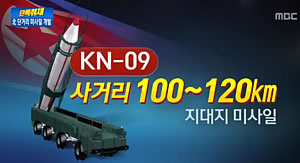
The biggest surprise is that AFGSC asserts that the KN-09 is nuclear-capable. There are few public reports about this weapon, but the South Korean television station MBC reported in April that it has a range of 100-120 km. MBC showed KN-09 as a ballistic missile, but AFGSC lists it as a CDCM (Coastal Defense Cruise Missile).
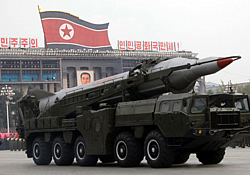
The Musudan IRBM is listed as “fielded” even though the missile, according to the U.S. Intelligence Community, has never been flight tested. In this case, “fielded” apparently means it has appeared but not that it is operational or necessarily deployed with the armed forces.
The Mushudan is listed as “fielded,” similar to the Russian SS-27, even though the North Korean missile has never been flight tested.
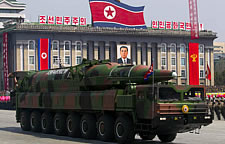
The KN-08 ICBM, which was displayed at the May 2012 parade, was widely seen by non-governmental analysts to be a mockup. But AFGSC obviously believes the weapon is real and expected to be “fielded” within the next five years. There were rumors in January 2013 that North Korea had started moving KN-08 launchers around the country at the beginning of a saber-rattling campaign that lasted through March.
Finally, the AFGSC briefing also predicts that North Korea will field a nuclear warhead within the next five year. Whether this refers to North Korea’s first weaponized warhead or newer types is unclear.
United Kingdom
![]()
The UK section does not include any weapons modernizations, which doesn’t quite capture what’s going on. For example, Britain is deploying the modified W76-1/Mk4A, which British officials have stated will increase the targeting capability of the Trident II D5 SLBM. Accordingly, a warhead icon has been added to the U.K. bar above.
Moreover, although the final approval has not been given yet, Britain is planning construction of a new SSBN to replace the current fleet of four Vanguard-class SSBNs. The missile section is under development in the United States. The new submarine will also receive the life-extended D5 SLBM.
United States
![]()
The U.S. section also does not show any nuclear modernizations, which glosses over important upgrades.
For example, the Minuteman III ICBM is in the final phases of a decade-long multi-billion dollar life-extension program that will extend the weapon to 2030. Privately, Air Force officials are joking that everything except the shell is new. Accordingly, a fielded ICBM icon has been added to the U.S. bar.
Moreover, full-scale production and deployment of the W76-1/Mk4A warhead on the Trident II D5 SLBM is underway. The combination of the new reentry body with the D5 increases the targeting capability of the weapon. Accordingly, a fielded warhead icon has been added to the U.S. bar.
In addition, from 2017 the U.S. Navy will begin deploying a modified life-extended version of the D5 SLBM (D5LE) on Ohio-class SSBNs. Production of the D5LE is currently underway, which will be “more accurate” and “provide flexibility to support new missions,” according to the navy and contractor. Accordingly, a forthcoming SLBM icon has been added to the U.S. bar.
Finally, the United States has begun design of a new SSBN class, a long-range bomber, a long-range cruise missile, a fighter-bomber, a guided standoff gravity bomb, and is studying a replacement-ICBM.
Hardly the dormant nuclear enterprise portrayed in the briefing.
France
![]()
France is listed with four nuclear modernizations, all well known: Triomphant SSBN, M51 SLBM, ASMP-A ALCM, and a new warhead.
The introduction of the ASMP-A is complete but the M51 SLBM is still replacing M45 SLBMs on the SSBN fleet.
The warhead section only appears to include the TNA warhead for the ASMP-A but ignores that France from 2015 will begin replacing the TN75 warhead on the M51 SLBM with the new TNO.
What is Meant by Nuclear and Fielded?
The AFGSC briefing is unclear and somewhat confusing about what constitutes a nuclear-capable weapon system and when it is considered “fielded.”
AFGSC confirmed to me that the slide only lists nuclear-capable weapon systems.
Air Force regulations are pretty specific about what constitutes a nuclear-capable unit. According to Air Force Instruction 13-503 regarding the Nuclear-Capable Unit Certification, Decertification and Restriction Program, a nuclear-capable unit is “a unit or an activity assigned responsibilities for employing, assembling, maintaining, transporting or storing war reserve (WR) nuclear weapons, their associated components and ancillary equipment.”
This is pretty straightforward when it comes to Russian weapons but much more dubious when describing North Korean systems. Russia is known to have developed miniaturized warheads and repeatedly test-flown them on missiles that are operationally deployed with the armed forces.
North Korea is a different matter. It is known to have detonated three nuclear test devices and test-launched some missiles, but that’s pretty much the extent of it. Despite its efforts and some worrisome progress, there is no public evidence that it has yet turned the nuclear devices into miniaturized warheads that are capable of being employed successfully by its ballistic or cruise missiles. Nor is there any public evidence that nuclear-armed missiles are operationally deployed with the armed forces.
Moreover, the U.S. Intelligence Community has recently issued strong statements that cast doubt on whether North Korea has yet mastered the technology to equip missile with nuclear warheads. James Clapper, the director of National Intelligence, testified before the Senate on April 18, 2013, that despite its efforts, “North Korea has not, however, fully developed, tested, or demonstrated the full range of capabilities necessary for a nuclear-armed missile.”
So how can the AFGSC briefing label North Korean ballistic missiles as nuclear-capable – and also conclude that the KN-09 cruise missile is nuclear-capable?
There are similar questions about the determination of when a weapon system is “fielded.” Does it mean it is fielded with the armed forces or simply that it has been seen? For example, how can a North Korean Musudan IRBM be considered fielded similarly to a Russia SS-27 ICBM?
Or how can the Musudan IRBM be identified as already “fielded” when it has not been flight tested and only displayed on parade, when the KN-08 is identified as not “fielded” even though it has also not been flight tested, also been displayed on parade, and even moved around North Korea?
Finally, how can the Russian Bulava SLBM and Kalibr SLCM be listed as “fielded” when their delivery platforms (Borei SSBN and Yasen SSGN, respectively) are listed as not fielded?
These inconsistencies cast doubt on the quality of the AFGSC briefing and whether it represents the conclusion of a coordinated Intelligence Community assessment, or simply is an effort to raise money in Congress for modernizing U.S. bombers and ICBMs.
Implications and Recommendations
There are still more than 17,000 nuclear weapons in the world and all the nuclear weapon states are busy maintaining and modernizing their arsenals. After Russia and the United States have insisted for decades that nuclear cruise missiles are essential for their security, the AFGSC briefing claims that China and North Korea are now trying to follow their lead.
For some, the AFGSC briefing will be (and probably already is) used to argue that nuclear threats against the United States and its allies are increasing and that Congress therefore should oppose further reductions of U.S. nuclear forces and instead approve modernizations of the remaining arsenal.
But Russia is not expanding its nuclear forces, the nuclear arsenals of China and Pakistan are much smaller than U.S. forces, and North Korea is in its infancy as a nuclear weapon state.
Instead, the rampant nuclear modernizations shown in the briefing symbolize struggling arms control and non-proliferation regimes that appear inadequate to turn the tide. They are being undercut by recommitments of a small group of nuclear weapon states to retain and improve nuclear forces for the indefinite future. The modernizations are partially being sustained by non-nuclear weapon states – often the very same who otherwise say they want nuclear disarmament – that insist on being protected by nuclear weapons.
The AFGSC briefing shows that there’s an urgent need for the international community to increase its pressure on the nuclear weapon states to curtail their nuclear programs. Especially limitations on MIRVed missiles are urgently needed. For its part, the Obama administration must reenergize its efforts to reduce the numbers and role of nuclear weapons.
There have been many nice speeches about reducing nuclear arsenals but too little progress on limiting the endless cycle of modernizations that sustain them.
Document: Air Force Global Strike Command Command Briefing
This publication was made possible by grants from the New-Land Foundation and Ploughshares Fund. The statements made and views expressed are solely the responsibility of the author.
Indian Army Chief: Nukes Not For Warfighting
 |
| Gen. V.K. Singh |
.
By Hans M. Kristensen
India’s nuclear weapons “are not for warfighting,” the chief of India’s army said Sunday at the Army Day Parade. The weapons have “a strategic capability and that is where it should end,” General V. K. Singh declared.
The rejection of nuclear warfighting ideas is a welcoming development in the debate over the role of nuclear weapons in South Asia. Pakistan’s military’s description of its new snort-range NASR missile as a “shoot and scoot…quick response system” has rightly raised concerns about the potential early use of nuclear weapons in a conflict.
NASR is one of several new nuclear weapon systems that are nearing deployment with warheads from a Pakistani stockpile that has nearly doubled since 2005.
India is also increasing its arsenal and already has short-range missiles with nuclear capability: the land-based Prithvi has been in operation for a decade, and a naval version (Dhanush) is under development. But India’s posture seems focused on getting its medium-range Agni II in operation, developing longer-range versions to target China, and building a limited submarine-based nuclear capability.
If Gen. Singh’s rejection of nuclear warfighting is reflected in India’s future nuclear posture, two important things will have been achieved: rejection of the mindless tit-for-tat philosophy that otherwise dominates nuclear posturing; and limiting the scenarios where nuclear weapons otherwise could come into use. The rejection also has importance for other nuclear weapon states, where some have called for making nuclear weapons more “tailored” to limited regional scenarios.
This publication was made possible by a grant from Carnegie Corporation of New York and Ploughshares Fund. The statements made and views expressed are solely the responsibility of the author.
Anatomizing Non-State Threats to Pakistan’s Nuclear Infrastructure
The discovery and subsequent killing of Osama bin Laden in Abbottabad, Pakistan raises troubling questions. The success of the U.S.’s airborne raid on bin Laden’s compound-undetected by Pakistan’s radar- lends credence to the belief that terrorists might be capable of successfully seizing Pakistan’s nuclear weapons.
Mr. Charles P. Blair has authored a new FAS report (PDF) that addresses the security gap and identifies specific terrorists within Pakistan who are motivated and potentially capable of taking Pakistani nuclear assets. Blair explains in the report details why, amid Pakistan’s burgeoning civil war, the Pakistani Neo-Taliban is the most worrisome terrorist group motivated and possibly capable of acquiring nuclear weapons.
Pakistani Nuclear Forces 2011
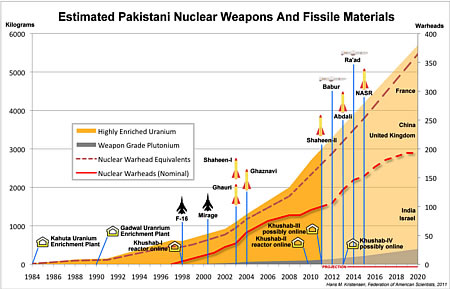 |
| Pakistan’s nuclear arsenal has doubled since 2004 and could double again in the next 10 years if the current trend continues, according to the latest Nuclear Notebook. Click on chart to download full size version. |
.
By Hans M. Kristensen and Robert S. Norris
The latest Nuclear Notebook on Pakistan’s nuclear forces is available on the Bulletin of the Atomic Scientists web site. Since our previous Notebook on Pakistan in 2009 there have been several important developments.
Based on our own estimates, official statements, and fissile material production estimates produced by the International Panel of Fissile Materials, we conclude that Pakistan’s current nuclear weapons stockpile of 90-110 warheads might increase to 150-200 within the next decade. This would bring the Pakistani stockpile within range of the British stockpile, the smallest of the original five nuclear weapon states, but still far from that of France (despite some recent news reports to the contrary).
This development is precipitated by the anticipated introduction of several new nuclear delivery systems over the next years, including cruise missiles and short-range ballistic missiles. The capabilities of these new systems will significantly change the composition and nature of Pakistan’s nuclear posture.
India is following this development closely and is also modernizing its nuclear arsenal and fissile material production capability. The growing size, diversity, and capabilities of the Pakistani and Indian nuclear postures challenge their pledge to only acquire a minimum deterrent. Bilateral arms control talks and international pressure are urgently needed to halt what is already the world’s fastest growing nuclear arms race.
This publication was made possible by a grant from Carnegie Corporation of New York and Ploughshares Fund. The statements made and views expressed are solely the responsibility of the author.
Pakistan’s “Shoot and Scoot” Nukes: FAS Nukes in Newsweek
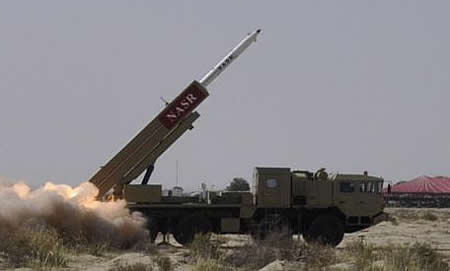 |
| Pakistan’s military describes its new short-range nuclear NASR missile as a “shoot and scoot…quick response system.” Image: ISPR |
.
By Hans M. Kristensen
Andrew Bast at Newsweek was kind enough to use our estimates for world nuclear forces in his latest article on Pakistan growing arsenal.
Of special interest is Pakistan’s production of the NASR (Hatf-9), a worrisome development for South Asia and the decade-long efforts to avoid nuclear weapons being used. With its range of only 60 kilometers, the multi-tube NASR system is not intended to retaliate against Indian cities but be used first against advancing Indian army forces in a battlefield scenario.
Pakistan’s military’s Inter Services Public Relations (ISPR) describes NASR as a system that “carries nuclear warheads of appropriate yield with high accuracy, shoot and scoot attributes” developed as a “quick response system” to “add deterrence value” to Pakistan’s strategic weapons development program “at shorter ranges” in order “to deter evolving threats.”
“Shoot and scoot…quick response system” ??
That sounds like an echo from nuclear battlefields in Europe at the height of the Cold War. It is time for Pakistan to explain how many nuclear weapons, of what kind, and for what purpose are needed for its minimum deterrent.
As bad as it is, though, talk about Pakistan’s nuclear arsenal passing the size of France at some point is, at the current rate, probably one or two decades ahead.
Don’t forget: Pakistan’s nuclear arsenal is not equal to the number of warheads that could potentially be produced by all the highly-enriched uranium and plutonium Pakistan might have produced. The size also depends on other factors such as the number of delivery vehicles and other limitations.
More information in the next Nuclear Notebook scheduled for publications in the Bulletin of the Atomic Scientists on July 1st.
This publication was made possible by a grant from Carnegie Corporation of New York and Ploughshares Fund. The statements made and views expressed are solely the responsibility of the author.
India and Pakistan: Whose is Bigger?
 |
| India-Pakistan nuclear competition on display again |
.
By Hans M. Kristensen
If Indian news reports (here, here, and here) are any indication, India has once again discovered that Pakistan might possess a few nuclear weapons more than India.
This time the reports are based on an article Robert Norris and I published in the Bulletin of the Atomic Scientists, in which we provide estimates for the number of nuclear weapons in the world.
In 2009, our report on Pakistan’s nuclear forces triggered a statement from the chief of the Indian army that if the warhead estimate in our report was correct then Pakistan had moved beyond what is needed for deterrence. The unintended acknowledgement: so had India.
In 2008, reports about the arrival of the first Chinese Jin-class SSBN at a naval base on Hainan Island were followed by suggestions that India needed to build perhaps five new Arihant-class ballistic missile submarines.
As far as I can gauge, apart from nuclear testing where India started first, Pakistan has always been a little ahead in warheads, fissile material, and delivery systems. But neither country can claim any nuclear moral high ground; both are increasing their nuclear arsenals, both are producing more fissile material for nuclear weapons, and both are diversifying the means to deliver nuclear weapons and extending their range.
The two countries are now at a warhead level about equal to that of Israel (~80 warheads). But whereas it took Israel 40 years to reach that level, India and Pakistan have done so in only 12 years. And they’re apparently not done.
Although neither government wants to say so publicly, India and Pakistan are in effect in a nuclear arms race. It might not be of the intensity of the Cold War arms race between the Soviet Union and the United States, but it is a race nonetheless for capability and systems. Pointing to the other side having more only underscores that dynamic.
Indian and Pakistani security will probably be served better by trying soon to define just how big a nuclear force is sufficient for minimum deterrence so that “prudent planning” doesn’t take them to a new and more dangerous level.
This publication was made possible by a grant from Carnegie Corporation of New York and Ploughshares Fund. The statements made and views expressed are solely the responsibility of the author.
Estimated Nuclear Weapons Locations 2009
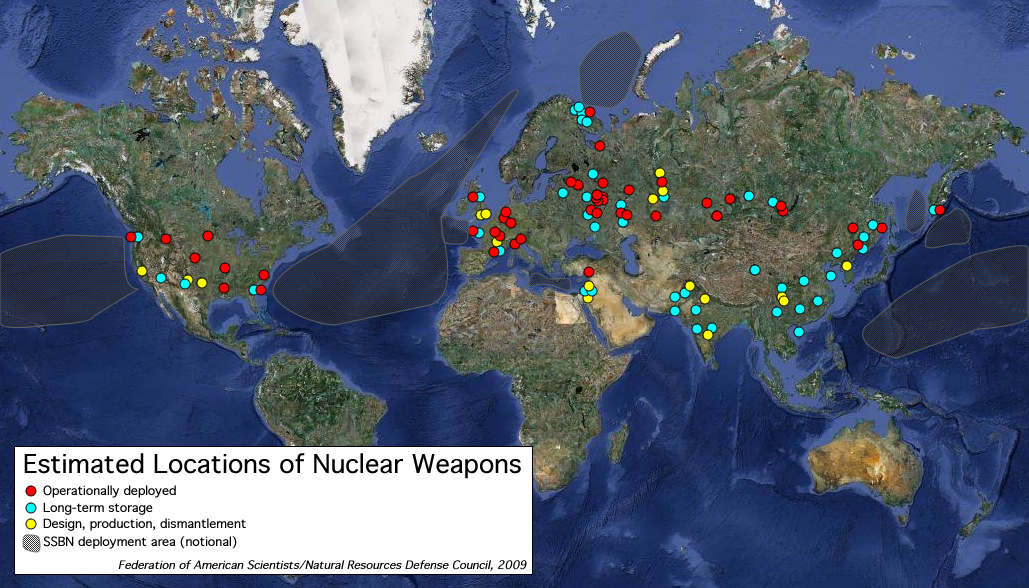
Some 23,300 nuclear weapons are stored at 111 locations around the world
.The world’s approximately 23,300 nuclear weapons are stored at an estimated 111 locations in 14 countries, according to an overview produced by FAS and NRDC.
Nearly half of the weapons are operationally deployed with delivery systems capable of launching on short notice.
The overview is published in the Bulletin of the Atomic Scientists and includes the July 2009 START memorandum of understanding data. A previous version was included in the annual report from the International Panel of Fissile Materials published last month.
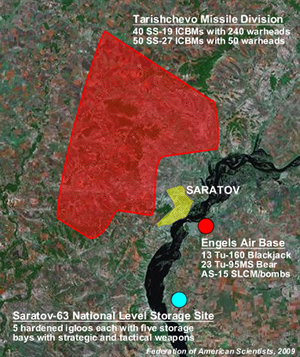
More than 1,000 nuclear weapons surround Saratov.
Russia has an estimated 48 permanent nuclear weapon storage sites, of which more than half are on bases for operational forces. There are approximately 19 storage sites, of which about half are national-level storage facilities. In addition, a significant number of temporary storage sites occasionally store nuclear weapons in transit between facilities.
This is a significant consolidation from the estimated 90 Russian sites ten years ago, and more than 500 sites before 1991.
Many of the Russian sites are in close proximity to each other and large populated areas. One example is the Saratov area where the city is surrounded by a missile division, a strategic bomber base, and a national-level storage site with probably well over 1,000 nuclear warheads combined (Figure 2).
The United States stores its nuclear weapons at 21 locations in 13 states and five European countries. This is a consolidation from the estimated 24 sites ten year ago, 50 at the end of the Cold War, and 164 in 1985 (see Figure 3).
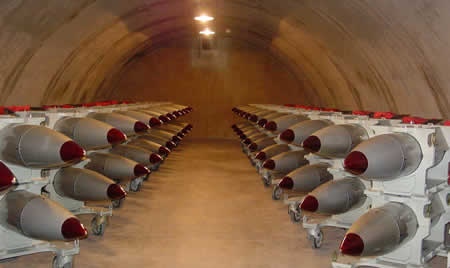
Approximately 50 B61 nuclear bombs inside an igloo at what might be Nellis Air Force Base in Nevada. Seventy-five igloos at Nellis store “one of the largest stockpile in the free world,” according to the U.S. Air Force, one of four central storage sites in the United States.
Europe has about the same number of nuclear weapon storage locations as the Continental United States, with weapons scattered across seven countries. This includes seven sites in France and four in Britain. Five non-nuclear NATO countries (Belgium, Germany, Italy, the Netherlands, and Turkey) still host U.S. nuclear weapons first deployed there during the Cold War.
We estimate that China has 8-14 facilities associated with nuclear weapons, most likely closer to the lower number, near bases with units that operate nuclear missiles or aircraft. None of the weapons are believed to be fully operational but stored separate from delivery vehicles at sites controlled by the Central Military Commission.
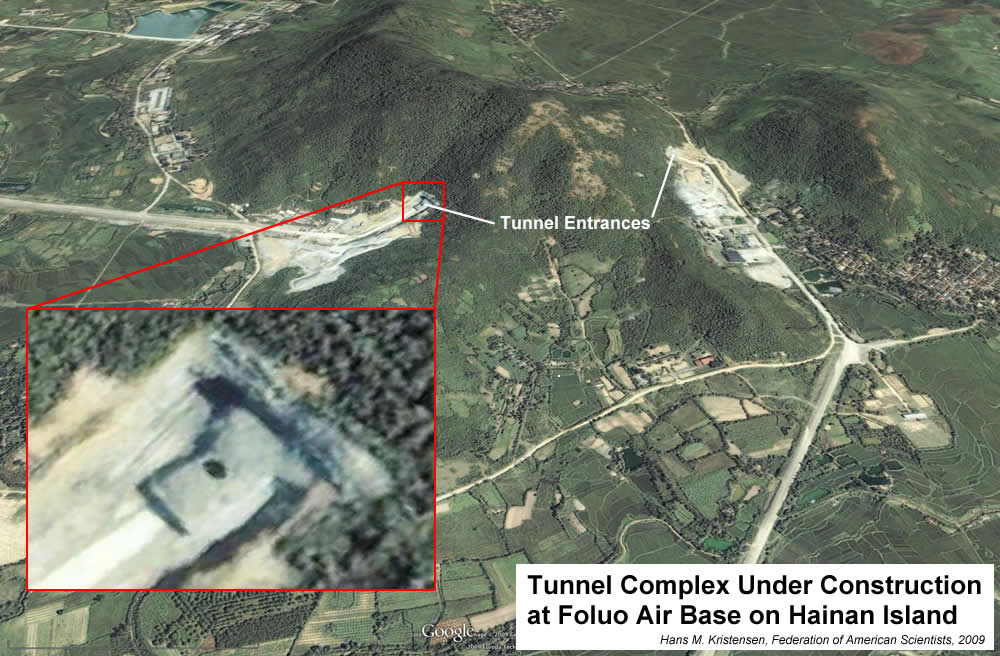
Where does China store nuclear warheads for its ballistic missile submarines? The naval base near Julin on Hainan Island has extensive underground facilities. An alternative to the base itself could potentially be a facility elsewhere on the island, such as Foluo Air Base where construction of an underground facility began five years before the first SSBN arrived at Hainan. Or are the weapons stored on the mainland? Click image to enlarge.
Israel probably has about four nuclear sites, whereas the nuclear storage facilities in India and Pakistan are – despite many rumors – largely undetermined. All three countries are thought to store warheads separate from delivery vehicles.
Despite two nuclear tests and many rumors, we are unaware of publicly available evidence that North Korea has operationalized its nuclear weapons capability.
Warhead concentrations vary greatly from country to country. With 13,000 warheads at 48 sites, Russian stores an average of 270 warheads at each location. The U.S. concentration is much higher with an average of 450 warheads at each location. These are averages, however, and in reality the distribution is thought to be much more uneven with some sites only storing tens of warheads.
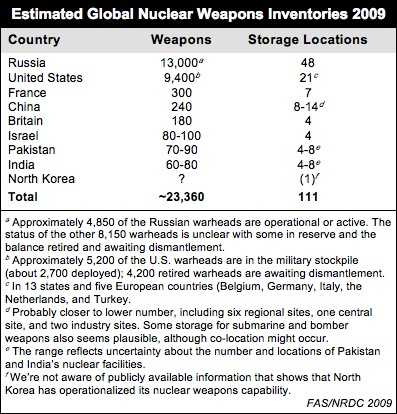
Finally, a word of caution is in order: estimates such as these obviously come with a great deal of uncertainty, as we don’t have access to classified intelligence estimates. Based on publicly available information and our own assumptions we have nonetheless produced a best estimate that we hope will assist the public debate. Comments and suggestions are encouraged so we can adjust the overview in the future.
This publication was made possible by a grant from Carnegie Corporation of New York and Ploughshares Fund. The statements made and views expressed are solely the responsibility of the author.
Pakistani Nuclear Forces 2009
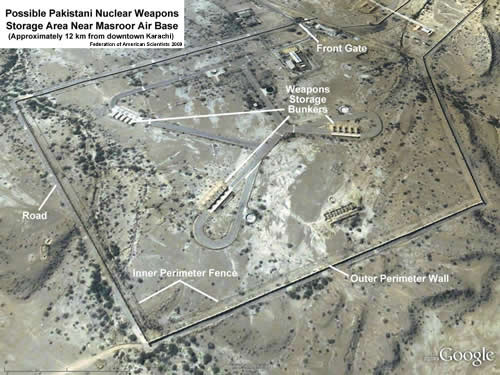 |
| A high-security weapons storage area northwest of Karachi appears to be a potential nuclear weapons storage site. (click image to download larger version) |
By Hans M. Kristensen
Pakistan’s nuclear weapons stockpile now includes an estimated 70-90 nuclear warheads, according to the latest Nuclear Notebook published in the Bulletin of the Atomic Scientists. The estimate is an increase compared with the previous estimate of approximately 60 warheads due to Pakistan’s pending introduction of a new ballistic missile and cruise missiles.
The increase in the warhead estimate does not mean Pakistan is thought to be sprinting ahead of India, which is also increasing its stockpile.
Modernizations
The nuclear-capable Shaheen-II medium-range ballistic missile appears to be approaching operational deployment after long preparation. The Army test-launched two missiles within three days in April 2008, and the U.S. Air Force National Air and Space Intelligence Center (NASIC) reported in June 2009 that the weapon “probably will soon be deployed.”
Two types of nuclear-capable cruise missiles are also under development; the ground-launched Barbur and the air-launched Ra-ad. The development of cruise missiles with nuclear capability is interesting because it suggests that Pakistan’s nuclear weapons designers have been successful in building smaller and lighter plutonium warheads.
Warhead Security Concerns
An article published in the July issue of the CTC Sentinel news letter of the Combating Terrorism Center at the U.S. Military Academy at West Point gained widespread attention for describing terrorist attacks against three of Pakistan’s rumored nuclear weapons facilities: Wah Ordnance Facility, Kamra Air Base, and Sargodha Weapons Storage Facility. Although the incidents had been reported before, the article triggered the predictable rejection from a Pakistani military spokesman but with the additional claim that neither facility stored nuclear weapons. “These are nowhere close to any nuclear facility,” he said. Yet the official would most likely not disclose the location of the nuclear weapons, even if he knew where they were.
While the CTC Sentinel article says “most” of Pakistan’s nuclear sites might be close to or even within terrorist dominated areas, senior U.S. officials said the weapons were secure and mostly located south of Islamabad.
Regardless of the actual location of the weapons, there have, of course, been many more terrorists attacks against other facilities that have nothing to do with Pakistan’s nuclear weapons program, and so far no pattern has emerged in public of a concerted terrorist effort against nuclear sites – much less an attempt to steel nuclear weapons. A U.S. intelligence official commented to the New York Times that it was unclear whether the attackers knew what the facilities contained. “If they were after something specific, or were truly seeking entry, you’d think they might use a different tactic, one that’s been employed elsewhere – such as a bomb followed by a small-arms assault.”
Pakistani and U.S. statements about the Pakistani nuclear arsenal, and the basis for our estimate, are included in the Nuclear Notebook.
Publication: Pakistani Nuclear Forces, 2009
New Air Force Intelligence Report Available
By Hans M. Kristensen
The Air Force Air and Space Intelligence Center (NASIC) has published an update to its Ballistic and Cruise Missile Threat. The document, which I obtained from NASIC, is sobering reading.
The latest update continues the previous user-friendly format and describes a number of important assessments and new developments in ballistic and cruise missiles of many of the world’s major military powers.
The report also helps dispel many web-rumors that have circulated about Chinese, Russian, Indian and Pakistani nuclear forces.
In this blog I’ll focus on the nuclear weapon states, particularly China.
Chinese Nuclear Forces
As the DF-3A retirement continues (there are now only 5-10 launchers left of close to 100 in the 1980s), the liquid-fuel missile is being replaced by a family of solid-fuel DF-21 variants. The NASIC identifies four, including two nuclear versions (Mod 1 and Mod 2), one conventional version, and an anti-ship version that unlike the others is not yet deployed.
Thankfully, the report dispels widespread speculation by web sites, news media, and even Jane’s after images began circulating on the Internet, that a DF-25 had been deployed, some even said with three nuclear warheads. But it was, as I predicted last year and NASIC now confirms, in fact a DF-21.
|
DF-21 Road-Mobile Launchers |
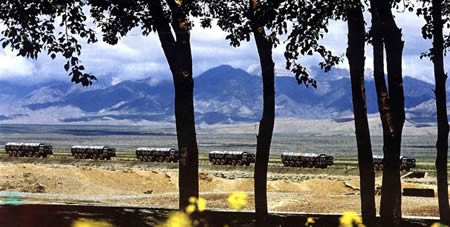 |
| A column of DF-21s on the road in what could be the Delingha deployment are in Qinghai Province. Several of the vehicles have identical camouflage patterns, raising suspicion that the image has been manipulated. Four DF-21 versions exist, two nuclear, one conventional, and one anti-ship version. Image: Web |
.
The report also reaffirms that the first of the DF-31s and DF-31As “have been deployed to units within the Second Artillery Corps,” and NASIC estimates that “less than 15” are deployed, up from the “less than 10” estimate in the Pentagon’s March 2009 report (which actually used 2008 data).
The NASIC report states that neither of China’s two types submarine-launched ballistic missiles is operational. This suggests that the multi-year overhaul of the JL-1 equipped Xia SSBN, which was completed last year, was not successful. The successor missile JL-2 for the new Jin-class SSBNs has not reached operational status either. NASIC gives the JL-2 the U.S. designation CSS-NX-14, not a numerical follow-on to the JL-1, which is listed as CSS-NX-3. The “14” could be a typo, but it appears several places in the report. The JL-2 is shown to have roughly the same dimensions as the Russian SS-N-32 SLBM.
NASIC lists single warheads on all of the Chinese missiles, not multiple warheads as speculated by many. “China could develop MIRV payloads for some of its ICBMs,” the report states. Yet it also predicts that, “Future ICBMs probably will include some with multiple independently-targetable reentry vehicles.” Whether that prediction – which appears to hint that China has more ICBMs under development – comes true remains to be seen, and the U.S. intelligence community has stated for years that one development that could trigger it is a U.S. ballistic missile defense system.
The report echoes recent statements from other branches of the U.S. intelligence community that the number of warheads on Chinese ICBM capable of reaching the United States could expand to “well over 100 in the next 15 years.” Unfortunately, “well over 100” can mean anything so it is hard to compare this NASIC’s projection with the CIA projection from 2001 of 75-100 warheads “primarily targeted against the United States” by 2015. That projection only included DF-5A and DF-31A capable of targeting all of the United States, with the high number requiring multiple warheads on DF-5A. But the timeline for the anticipated increase has slipped considerably from 2015 to 2024.
.
Moreover, ICBMs “primarily targeted against the United States” is a smaller group of missiles than those “capable of reaching the United States,” which currently includes about 60 DF-4, DF-5A, DF-31 and DF-31A ICBMs with as many warheads. For this group to grow to “well over 100 warheads” suggests that NASIC anticipates that China will deploy at least 60-70 DF-31, DF-31A and JL-2 missiles by 2024 (the DF-4 will probably have been retired by then). Assuming that includes 36 JL-2s on three Jin-class SSBNs, an additional 20-30 total DF-31s and DF-31As would have to be deployed to reach 120 ICBM warheads. If five SSBNs were deployed, then only 10 additional land-based ICBMs would be required, or 30 if the 20 DF-5As were retired.
The DH-10 land-attack cruise missile is listed as “conventional or nuclear,” the same designation used for the nuclear and conventional Russian AS-4. But unlike the 2009 DOD report on Chinese military forces, which lists 150-350 DH-10s deployed with 40-50 launchers, NASIC lists the operational status as “undetermined.”
Russian Nuclear Forces
NASIC states that “Russia retains about 2,000 warheads on ICBMs,” which is far too many for the land-based ICBM force and so probably includes SLBMs as well. The ICBM force will continue to decrease due to arms control agreements, aging missiles, and resource constraints. Even so, “Russia will probably retain the largest ICBM force outside the United States,” and “most of these missiles are maintained on alert, capable of being launched within minutes of receiving a launch order,” according to NASIC.
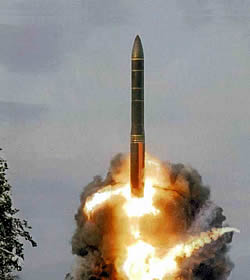 |
|
The multiple-warhead RS-24 ICBM is, according to NASIC, not a new missile but a modified version of the SS-27 (Topol-M). |
The NASIC report formally designates the “multiple” warhead RS-24 ICBM to be a modification of the SS-27 Mod 1. This has some significance because Russia under START is not allowed to increase the warhead loading on missiles declared under the treaty, but in anticipation of the treaty expiring in December 2009 apparently has been working on doing so anyway. The RS-24, which will exist in both silo and road-mobile versions, is not yet deployed but Russian military officials have said this will happen in December.
On the submarine force the modified SS-N-23 known as Sineva is listed as carrying the same number of warheads (4) as the original version, far less than the “up to 10” listed by NASIC in 2006 and by Russian news media. The range is listed as the usual 8,000+ km even though the Russian Navy claimed in October 2008 to have test-flown the missile to 11,547 km. NASIC also continues to list two remaining Typhoon-class SSBNs as capable of carrying the SS-N-20, even though the missile is reported to have been withdrawn from service. I suspect this is because the report uses START-counted missile tubes. A third Typhoon SSBN has been converted as a test platform for the SS-N-32/Bulava-30, and NASIC lists this submarine with 20 tubes for the new missile.
Interestingly, the kh-102 cruise missile, a replacement for the AS-15 long rumored to be under development, is not listed by NASIC.
Indian Nuclear Forces
Even though Indian news media reports and private/corporate institutes have reported for years that Agni I and Agni II were deployed, the NASIC report shows that operational deployment of the road-mobile Agni I SRBM has only recently begun, with “fewer than 25” missile launchers deployed. NASIC seems to back our assessment from last year that the Agni II at that time was not yet fully operational, by listing “fewer than 10” launchers deployed.
Two short-range sea-based ballistic missiles are under development: Dhanush and Sagarika. Neither is operational yet, and NASIC safely estimates that the Sagarika will become operational sometime after 2010.
Despite Indian news media reports of development of a nuclear-capable cruise missile, no mentioning of such a weapon system is made by NASIC.
Pakistani Nuclear Forces
There are fewer than 50 launchers for the road-mobile Ghaznavi and Shaheen I SRBMs listed in the NASIC report, and the 2,000+ km Shaheen II MRBM is not yet operational but may be soon. Pakistan also appears to have two nuclear-capable cruise missiles under development: the ground-launched Babur and the air-launched Ra’ad.
Other Nuclear Weapon States
Although “friendly” nuclear weapon states are not included because they are not a “threat” to the United States, the report’s section on cruise missiles is nonetheless interesting because it – unlike the ballistic missile sections – describes weapon systems of “friendly” nuclear weapon states such as France and Israel. Yet nuclear systems, such as the French ASMP-A, are excluded. Israeli submarine-based cruise missiles, which have been rumored to have nuclear capability (I’m not convinced), are not included either.
Curiously, even after two nuclear tests and the intelligence community stating for more than a decade that North Korea has nuclear weapons, the NASIC report does not list any of North Korea’s weapons as “nuclear” or “conventional or nuclear.” That is, I think, interesting.
Background Information: 2009 NASIC report | Previous NASIC reports



